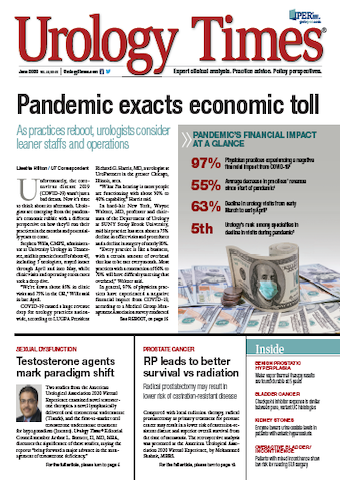Publication
Article
Urology Times Journal
Pandemic exacts economic toll on urology practices
Author(s):
As practices reboot, urologists consider leaner staffs and operations.
Unfortunately, the coronavirus disease 2019 (COVID-19) wasn’t just a bad dream. Now it’s time to think about its aftermath. Urologists are emerging from the pandemic’s economic rubble with a different perspective on how they’ll run their practices in the months and potentially years to come.
Stephen Wills, CMPE, administrator at University Urology in Tennessee, said his practice’s
Stephen Wills, CMPE

staff of about 45, including 5 urologists, stayed intact through April and into May, while clinic visits and operating room cases took a deep dive.
“We’re down about 65% in clinic visits and 75% in the OR,” Wills said in late April.
COVID-19 caused a huge revenue drop for urology practices nationwide, according to LUGPA President Richard G. Harris, MD, a urologist at UroPartners in the greater Chicago, Illinois, area.
“What I’m hearing is most people are functioning with about 30% to 40% capability,” Harris said.
In hard-hit New York, Wayne Waltzer, MD, professor and chairman of the Department of Urology at SUNY Stony Brook University, said his practice has seen about a 75% decline in
Wayne Waltzer, MD

office visits and procedures and a decline in surgery of nearly 90%.
“Every practice is like a business, with a certain amount of overhead that has to be met every month. Most practices with a contraction of 60% to 70% will have difficulty meeting that overhead,” Waltzer said.
In general, 97% of physician practices have experienced a negative financial impact from COVID-19, according to a Medical Group Management Association survey conducted April 7-8. US practices reported a 60% average decrease in patient volume and a 55% average decrease in revenue since the pandemic started, according to the Medical Group Management Association.1
Researchers at Harvard University and the health care technology company Phreesia analyzed nationwide data on changes in visit volume for more than 50,000 providers and found the number of visits to ambulatory practices fell nearly 60% in mid-March and remained low through mid-April.2 They reported dramatic declines in visits in all US regions, with the greatest declines in New England and the Mid-Atlantic states.
Surgical and procedural specialties like urology were harder hit. Urology ranked tied for fifth among specialties in terms of greatest decline in visits during the pandemic, with a 63% drop from early March to early April, the Harvard/Phreesia study found. Ophthalmology and otolaryngology experienced the biggest declines, with visits dropping an average 79% and 75%, respectively.
Staying the course
Many practices initially reacted to the pandemic thinking they’d have to lay off staff. The Federal Government prevented some of those layoffs, or furloughs, with grant and loan
Owen Dahl

programs that are helping to buoy practices until the crisis subsides, according to Owen Dahl, a health care business consultant.
The Coronavirus Aid, Relief, and Economic Security Act Paycheck Protection Program (PPP) has helped many practices retain staff. It requires that employers pay 75% of their employees at 75% or more of payroll, according to Dahl.
Technically, the PPP is a loan but could be forgiven if practices meet the government’s criteria. The government has also helped to keep practices afloat with grants or stimulus money. The Families First Coronavirus Response Act requires employers to provide their employees with paid sick leave or expanded family and medical leave for COVID-19–related reasons, and the Economic Injury Disaster Loan option is available through the Small Business Administration.
University Urology, which has not cut anybody’s pay or furloughed staff, applied for and received a PPP loan.
“Without that, we would have to use much more drastic measures than we have. I think that’s going to get us by for at least a couple of months. We also did get a little stimulus from Health and Human Services,” Wills said. “If it continues well into the summer and into the winter, we’re definitely going to have to reevaluate.”
Although the infusion of money has been a big help for some practices, not all have received a PPP loan or other funds. The other problem is government grants and loans only will go so far—until about the beginning of June to mid-June, according to Dahl.
Brace yourselves
Medicine’s revenue cycle tends to lag about 2 months after practices bill for services. Urologists might not have realized the full impact of the COVID-19 monetary crisis until May or into June, according to Harris.
Still, if COVID-19 abates sooner than expected, physicians and hospitals might fare well due to excess demand for services deemed essential, according to the authors of a recent Viewpoint article in JAMA.3 “If the COVID-19 shutdown lasts for months or the normal business of health care does not resume until the fall, the implications for physicians and hospitals would be much more severe,” the authors wrote. “The bank accounts of many practices are not large enough to absorb a long-term shutdown.”
The recovery for procedurally oriented specialists, including urologists, will resemble a U-shape rather than a V-shape, according to Travis Singleton, executive vice president Merritt Hawkins, a health care search and consulting firm.
“It will take some time for employment to rebound and for patients to reestablish both the health care coverage and the confidence they need to move forward with procedures that
Travis Singleton

can otherwise be postponed,” Singleton said. “While primary care physicians can pivot to telehealth and be paid for many of the services they provide, urologists can’t perform cystoscopies and other procedures virtually.
“However, the underlining dynamics that are driving demand for urologists and other specialists, particularly population aging, remain in place. Demand will return, and with it the need to recruit urologists and other needed health care professionals and support staff.”
Telehealth is more than a transition
Experts say telehealth is a lifeline. Waltzer said ramping up his practice’s telehealth services has helped to keep his staff on the job.
“Telemedicine has really essentially risen up and become a very dominant piece of urology practice,” he said. “We have staff calling patients, scheduling appointments, and converting some [of these appointments] to telemedicine. This is very time consuming. But telehealth visits are helping our practice and others increase billing.”
Wills said that University Urology doctors were each seeing about 10 patients daily in the office in late April and were conducting about another 25 telehealth visits each day.
“We’re just starting to get payments in for things that we have been billing the last few weeks and, for the most part, insurance companies are paying as if the patients were in the office. Telehealth will probably be one of the redeeming factors that will get us through all of this,” Wills said.
Telemedicine is slowly ramping up at UroPartners and should help pay the bills as the practice resumes in-person appointments and elective procedures, according to Harris.
Richard G. Harris, MD

“In a normal month, we have between 16,000 and 18,000 evaluation and management code submissions. Right now, the telehealth code submissions are in the 3,000 to 4,000 range. That’s double what it was a month ago,” Harris said in late April.
If laws remain relaxed for telehealth use, the trend for increasing utilization will continue in urology. LUGPA is lobbying for the government to keep telehealth regulations as they have been during the pandemic, according to Harris.
The next 3 to 6 months
The biggest concern for practices after the pandemic is whether they have the staff needed to go forward, according to Dahl.
“If they were able to retain the employees and maintain good communication and relationships with the staff, that makes life a whole lot easier when they reopen,” he said.
Communicating with patients is the other piece of a successful reboot.
“What we’re finding is that a lot of patients who had urgent or what could be urgent medical needs didn’t seek care,” Dahl said. “What I think is critical is how the practice communicates with those patients. Have they adequately communicated up to now and can they reestablish relationships with those patients? We need to make sure that they know we’re open for business. And that would include things like posting on the website, things like emails, texts, different ways to reach out to those patients.”
Relationship building will help practices move forward. That includes relationships with the staff and addressing the issues they might have related to the pandemic. Practice administrators or managers need to listen and meet staff members’ needs where possible.
A seamless transition to a new normal includes providing staff with adequate training in new practice areas, such as telemedicine, according to Dahl.
Doctors will have to look at and revise scheduling models to better respond to patients’ needs, Dahl said. That includes attending to patients’ safety and improving workflow so they don’t have to wait for their appointments when they do come to the office.
Wills anticipates that patient foot traffic will double or triple through the summer and hopes the practice will be running according to a new normal in 6 months, assuming there’s no second wave.
University Urology plans to continue taking safety precautions for patients and staff for the long term. Like many practices, University Urology will likely shrink daily templates for office visits and focus on making operations and staffing leaner and more efficient even when the pandemic is a memory.
“We won’t look at staffing as the luxury that we have in the past because of the fear that anything could happen again and all of a sudden,” Wills said. “I think we’ll be more cognizant of who we hire and when we hire. If people move on to other places, we might not replace them. I’d say we’ll get a little more lean and mean in general.”
Waltzer said a lesson he learned during the pandemic is the value of communication. Clear, consistent communication will continue to help practices act on future uncertainty.
“We’ve really learned about the value of using both Microsoft Teams and Zoom for meetings. Those 2 things really help us to get people together, sometimes literally on a daily basis to discuss issues,” Waltzer said. “It really makes the planning much easier because you can get large groups of people together at 1 time instead of trying to have sequential meetings. For our own urology department, we have a daily briefing with our practice managers, office managers, and advanced practitioners to make sure we’re doing what we have to do to serve our patients.”
Waltzer said that despite being in the country’s epicenter of COVID-19 cases, he believes urology practices can and will recover.
“The time frame is of course uncertain because everyone is worried about the second surge, particularly in very dense urban areas. But I think going forward, there are some good lessons that are coming out of this as far as managing patients with telemedicine, particularly older patients for whom it may be difficult to travel,” said Waltzer, who noted his practice hasn’t changed plans to welcome 2 new urologists at summer’s end.
Just don’t expect business as usual. That’s not going to happen, Dahl said.
“The way we’ve always done it is gone and should be gone,” he said.
References
1. COVID-19 financial impact on medical practices. Medical Group Management Association. Accessed May 18, 2020. https://www.mgma.com/getattachment/9b8be0c2-0744-41bf-864f-04007d6adbd2/2004-G09621D-COVID-Financial-Impact-One-Pager-8-5x11-MW-2.pdf.aspx?lang=en-US&ext=.pdf
https://www.commonwealthfund.org/publications/2020/apr/impact-covid-19-outpatient-visits
2. Mehrotra A, Chernew M, Linetsky D, Hatch H, Cutler D. What impact has COVID-19 had on outpatient visits? The Commonwealth Fund. April 23, 2020. Accessed May 18, 2020. https://www.commonwealthfund.org/publications/2020/apr/impact-covid-19-outpatient-visits
3. Cutler DM, Nikpay S, Huckman RS. The business of medicine in the era of COVID-19. May 1, 2020. Accessed May 18, 2020. doi:10.1001/jama.2020.7242 https://jamanetwork.com/journals/jama/fullarticle/2765668?guestAccessKey=85145fdc-9111-4f32-b0f0-cdc65e0d0bed&utm_source=For_The_Media&utm_medium=referral&utm_campaign=ftm_links&utm_content=tfl&utm_term=050120
Cover sources
1. COVID-19 financial impact on medical practices. Medical Group Management Association. Accessed May 18, 2020. https://www.mgma.com/getattachment/9b8be0c2-0744-41bf-864f-04007d6adbd2/2004-G09621D-COVID-Financial-Impact-One-Pager-8-5x11-MW-2.pdf.aspx?lang=en-US&ext=.pdf
https://www.commonwealthfund.org/publications/2020/apr/impact-covid-19-outpatient-visits
2. Mehrotra A, Chernew M, Linetsky D, Hatch H, Cutler D. What impact has COVID-19 had on outpatient visits? The Commonwealth Fund. April 23, 2020. Accessed May 18, 2020. https://www.commonwealthfund.org/publications/2020/apr/impact-covid-19-outpatient-visits
Newsletter
Stay current with the latest urology news and practice-changing insights — sign up now for the essential updates every urologist needs.






















